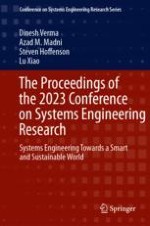2024 | Book
The Proceedings of the 2023 Conference on Systems Engineering Research
Systems Engineering Towards a Smart and Sustainable World
Editors: Dinesh Verma, Azad M. Madni, Steven Hoffenson, Lu Xiao
Publisher: Springer Nature Switzerland
Book Series : Conference on Systems Engineering Research Series
